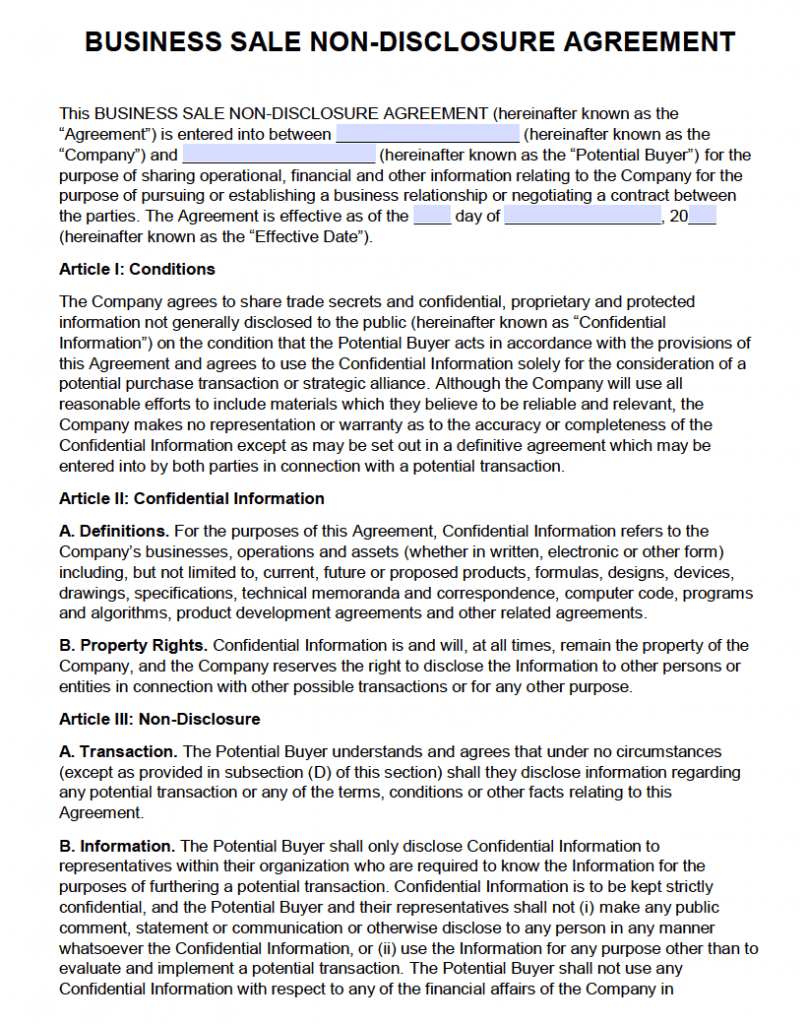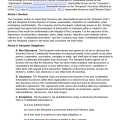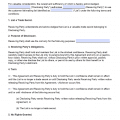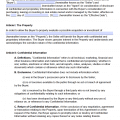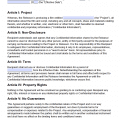Business Sale Non-Disclosure Agreement (NDA)

The business sale non-disclosure agreement is used when you’re engaged in negotiations to purchase an entity. For example, merger or investment discussions, negotiations about joint ventures or talks with consultants or potential licensees. All information about how the business obtains its customers and details about their products and services must be kept confidential. In the case of competitors, any trade secrets or proprietary information that is obtained may not be used if a sale is not completed.
Sample
BUSINESS INFORMATION NON-DISCLOSURE AGREEMENT
This agreement between _________________ (the “Disclosing Party”) and _________________ (the “Receiving Party”) is effective _________________. It is entered into to prevent the unauthorized disclosure of Confidential Information (as defined below) of Disclosing Party which may be disclosed to Receiving Party for the purpose of pursuing or establishing a business relationship or negotiating a contract between the parties. Accordingly, the parties agree as follows:
[Alternative 1]
The following information constitutes confidential proprietary trade secret information (“Confidential Information”) belonging to Disclosing Party: _________________.
[Alternative 2]
Disclosing Party’s confidential proprietary trade secret information (“Confidential Information”) consists of information and materials that are valuable and not generally known by Disclosing Party’s competitors. Confidential Information includes:
(a) Any and all information concerning Disclosing Party’s current, future or proposed products, including, but not limited to, formulas, designs, devices, computer code, drawings, specifications, notebook entries, technical notes and graphs, computer printouts, technical memoranda and correspondence, product development agreements and related agreements.
(b) Information and materials relating to Disclosing Party’s purchasing, accounting, and marketing, including, but not limited to, marketing plans, sales data, business methods, unpublished promotional material, cost and pricing information and customer lists.
(c) Information of the type described above which Disclosing Party obtained from another party and which Disclosing Party treats as confidential, whether or not owned or developed by Disclosing Party.
(d) Other: _________________.
Receiving Party will treat Confidential Information with the same degree of care and safeguards that it takes with its own Confidential Information but in no event less than a reasonable degree of care. Without Disclosing Party’s prior written consent, Receiving Party will not:
(a) disclose Confidential Information to any third party;
(b) make or permit to be made copies or other reproductions of Confidential Information; or
(c) make any commercial use of Confidential Information.
Receiving Party will carefully restrict access to Confidential Information to those of its officers, directors and employees who are subject to non-disclosure restrictions at least as protective as those set forth in this Agreement and who clearly need such access to participate on Receiving Party’s behalf in the analysis and negotiation of a business relationship or any contract or agreement with Disclosing Party.
Receiving Party will advise each officer, director or employee to whom it provides access to any Confidential Information that they are prohibited from using it or disclosing it to others without Disclosing Party’s prior written consent.
[Optional]
In addition, without the prior written consent of Disclosing Party, Receiving Party shall not disclose to any person either the fact that discussions or negotiations are taking place concerning a possible transaction or the status of such discussions or negotiations.
Upon Disclosing Party’s request, Receiving Party shall within 30 days return all original materials provided by Disclosing Party and any copies, notes or other documents in Receiving Party’s possession pertaining to Confidential Information.
This agreement does not apply to any information that:
(a) was in Receiving Party’s possession or was known to Receiving Party, without an obligation to keep it confidential, before such information was disclosed to Receiving Party by Disclosing Party;
(b) is or becomes public knowledge through a source other than Receiving Party and through no fault of Receiving Party;
(c) is or becomes lawfully available to Receiving Party from a source other than Disclosing Party; or
(d) is disclosed by Receiving Party with Disclosing Party’s prior written approval.
[Alternative 1]
This Agreement and Receiving Party’s duty to hold Confidential Information in confidence shall remain in effect until Confidential Information is no longer a trade secret or until Disclosing Party sends Receiving Party written notice releasing Receiving Party from this Agreement, whichever occurs first.
[Alternative 2]
This Agreement and Receiving Party’s duty to hold Confidential Information in confidence shall remain in effect until _________________ or until whichever of the following occurs first:
(a) Disclosing Party sends Receiving Party written notice releasing it from this Agreement, or
(b) Confidential Information disclosed under this Agreement ceases to be a trade secret.
This Agreement does not constitute a grant or an intention or commitment to grant any right, title or interest in Confidential Information to Receiving Party.
Disclosing Party warrants that it has the right to make the disclosures under this Agreement.
8. General Provisions
(a) Relationships: Nothing contained in this Agreement shall be deemed to constitute either party a partner, joint venturer or employee of the other party for any purpose.
(b) Severability: If a court finds any provision of this Agreement invalid or unenforceable, the remainder of this Agreement shall be interpreted so as best to effect the intent of the parties.
(c) Integration: This Agreement expresses the complete understanding of the parties with respect to the subject matter and supersedes all prior proposals, agreements, representations and understandings. This Agreement may not be amended except in a writing signed by both parties.
(d) Waiver: The failure to exercise any right provided in this Agreement shall not be a waiver of prior or subsequent rights.
(e) Injunctive Relief: Any misappropriation of Confidential Information in violation of this Agreement may cause Disclosing Party irreparable harm, the amount of which may be difficult to ascertain, and therefore Receiving Party agrees that Disclosing Party shall have the right to apply to a court of competent jurisdiction for an order enjoining any such further misappropriation and for such other relief as Disclosing Party deems appropriate. This right of Disclosing Party is to be in addition to the remedies otherwise available to Disclosing Party.
(f) Indemnity: Receiving Party agrees to indemnify Disclosing Party against any and all losses, damages, claims or expenses incurred or suffered by Disclosing Party as a result of Receiving Party’s breach of this Agreement.
(g) Attorney Fees and Expenses: In a dispute arising out of or related to this Agreement, the prevailing party shall have the right to collect from the other party its reasonable attorney fees and costs and necessary expenditures.
(h) Governing Law. This Agreement shall be governed in accordance with the laws of the State of _________________.
(i) Jurisdiction. The parties consent to the exclusive jurisdiction and venue of the federal and state courts located in _________________ in any action arising out of or relating to this Agreement. The parties waive any other venue to which either party might be entitled by domicile or otherwise.
(j) Successors & Assigns.
[Alternative 1]
This Agreement shall bind each party’s heirs, successors and assigns. Receiving Party may not assign or transfer its rights or obligations under this Agreement without the prior written consent of Disclosing Party. Any assignment or transfer in violation of this section shall be void.
[Alternative 2 (consent not unreasonably withheld)]
This Agreement shall bind each party’s heirs, successors and assigns. Receiving Party may not assign or transfer its rights or obligations under this Agreement without the prior written consent of Disclosing Party. Such consent shall not be unreasonably withheld. Any assignment or transfer in violation of this section shall be void.
[Alternative 3 (consent not needed for affiliates or new owners)]
This Agreement shall bind each party’s heirs, successors and assigns. Receiving Party may not assign or transfer its rights or obligations under this Agreement without the prior written consent of Disclosing Party. However, no consent is required for an assignment or transfer that occurs: (a) to an entity in which Receiving Party owns more than fifty percent of the assets; or (b) as part of a transfer of all or substantially all of the assets of Receiving Party to any party. Any assignment or transfer in violation of this section shall be void.
Disclosing Party:
_____________________________________________ (Signature)
_____________________ (Typed or Printed Name)
Title: _____________________
Date: _____________________
Receiving Party:
_____________________________________________ (Signature)
_____________________ (Typed or Printed Name)
Title: _____________________
Date: _____________________
How to Write
Introductory Paragraph
Fill in the date the agreement will take effect. This can be the date it’s signed or a date in the future. Next, fill in your company name (you are the disclosing party). Finally, fill in the name of the outside individual or company being granted access to your trade secrets (the Receiving Party).
Select either Alternative 1 or 2, and delete the other. Here’s how to choose:
- Alternative 1. Use this clause if you can individually list the material being provided. However, be careful that your description is not so narrowly worded that it may leave out important information you want to be covered by the agreement.
- Alternative 2. Use this clause if it’s not possible to specifically identify the trade secrets. For example, if the information to be disclosed does not yet exist. This clause contains a general description of the types of information covered.
This clause makes clear that your trade secrets must be kept in confidence by the receiving party and may not be revealed to others without your prior written consent. It contains an optional provision requiring the fact that negotiations taking place are to be kept secret.
Here, the receiving party promises to return original materials provided by your company, as well as copies, note, and documents pertaining to the trade secrets. The form gives the receiving party 30 days to return the materials, but you can change this time period if you wish.
This provision describes all the types of information that are not covered by the agreement. These exclusions are based on court decisions and state trade secret laws that say these types of information do not qualify for trade secret protection.
There are two alternate provisions dealing with how long the agreement will stay in effect. Select the clause that best suits your needs and delete the other:
- Alternative 1. This provision has no definite time limit-in other words, the receiving party must keep mum until the trade secret ceases to be a trade secret. This may occur when the information becomes generally known, you disclose it to the public, or it ceases being a trade secret for some other reason. This gives you the broadest protection possible.
- Alternative 2. Some receiving parties don’t want to be subject to open-ended confidentiality obligations. Use this clause if the receiving party insists that the agreement contain a definite expiration date. The Agreement should last as long as the information is likely to remain a trade secret. Five years is a common period, but it can be much shorter, even as little as six months. In Internet and technology businesses, the time period may need to be shorter because of the fast pace of innovation.
This clause makes clear that you are not granting any ownership rights in the confidential information to the receiving party.
A warranty is a promise. Here, you promise the receiving party that you have the right to disclose the information. This is intended to assure the receiving party that it won’t be sued by some third party claiming that the trade secrets belonged to it and that you had no right to reveal them to the receiving party.
